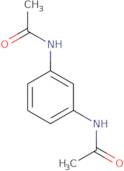N,N'-(1,3-Phenylene)diacetamide
CAS: 10268-78-7
Ref. 3D-KAA26878
| 1g | Discontinued | ||
| 5g | Discontinued | ||
| 10g | Discontinued | ||
| 250mg | Discontinued | ||
| 500mg | Discontinued | ||
| 2500mg | Discontinued |
Product Information
- 1,3-Bisacetamidobenzene
- 1,3-Diacetamidobenzene
- Acetamide, N,N'-1,3-phenylenebis-
- Acetamide, N,N'-m-phenylenebis- (6CI,7CI,8CI)
- Acetamide, N,N′-m-phenylenebis-
- Brn 0910978
- N,N'-1,3-Phenylenebisacetamide
- N,N'-Diacetyl-1,3-phenylenediamine
- N,N'-benzene-1,3-diyldiacetamide
- N,N′-1,3-Phenylenebis[acetamide]
- See more synonyms
- N,N′-Diacetyl-1,3-diaminobenzene
- N,N′-Diacetyl-m-phenylenediamine
- NSC 7204
- Nsc 62829
- m-N,N′-Diacetylphenylenediamine
- m-Phenylenediacetamide
N,N'-(1,3-Phenylene)diacetamide (NDPA) is a sensitizer that has been shown to be an animal carcinogen. It is found in nitrocellulose and other organic solvents and can be used as a developer in electrophotography. NDPA has two optical isomers, 1-phenyl-2-acetamidobenzene (PABA) and 2-phenyl-1-acetamidobenzene (NPDPA). The physiochemical properties of these two compounds are similar, but the 1-phenyl isomer (PABA) appears to be more toxic than the 2-phenyl isomer (NPDPA). The elimination rate for NDPA depends on age group, with children showing a lower elimination rate than adults. Sprague Dawley rats were the most sensitive animals studied for toxicity by NDPA.





